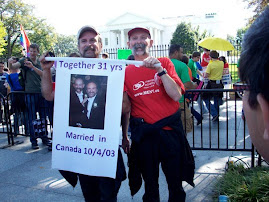Growing research suggests being gay is not 'a choice' - San Jose Mercury News
By Mike Swift
Mercury News
Posted: 11/29/2008 07:13:00 PM PST
Compared with straight men, gay men are more likely to be left-handed, to be the younger siblings of older brothers, and to have hair that whorls in a counterclockwise direction.
Researchers are finding common biological traits among gay men, feeding a growing consensus that sexual orientation is an inborn combination of genetic and environmental factors that largely decide a person's sexual attractions before they are born.
Such findings — including a highly anticipated study this winter — would further inform the debate over whether homosexuality is innate or a choice, an undercurrent of the recent Proposition 8 campaign in which television commercials warned that "schools would begin teaching second-graders that boys could marry boys," suggesting homosexuality would then spread.
Some scientists say the political and moral debate over same-sex marriage frequently strayed from established scientific evidence, including comments by vice presidential candidate Sarah Palin that homosexuality is "a choice" and "a decision."
Until 2007, CNN polls had found that a majority of Americans believed gay people could change their sexual orientation if they chose to; it was only last year that a majority for the first time said homosexuality was an inborn trait. Christian groups such as Exodus International argue "that homosexuals who desire to change can do so." One prominent psychiatrist, Dr. Robert Spitzer of Columbia University, found controversial evidence that therapy can cause some gay people to change to a heterosexual orientation, although the study concluded that a "complete change" was uncommon.
While sexual behavior may be chosen, the preponderance of researchers say attraction is dictated by biology, with no demonstrated contribution from social factors such as parenting or other factors after birth.
A host of studies since the mid-1990s have found common biological traits between gay men, including left-handedness and the direction of hair whorls. The likelihood that if one identical twin is gay, the other will also be gay is much higher than the "concordance" of homosexuality between fraternal twins, indicating that genes play a role in sexual orientation, but are not the entire cause.
"In the past decade, I think the pendulum has swung more toward biological theory and biological causes," said Richard Lippa, a psychology professor at California State University-Fullerton, who has studied hair patterns and other biological traits in gay men."
Sven Bocklandt, a geneticist at the David Geffen School of Medicine at UCLA, is bewildered by the argument that people choose their sexual attraction. He said that virtually every animal species that has been studied — from sheep to fruit flies — has a small minority of individuals who demonstrate homosexual activity.
"I really believe the reason most humans are straight is the same reason that most crocodiles are straight, and the same reason most whales are straight," Bocklandt said. "Nature would not leave something so important for reproduction, for the survival of the species, to coincidence."
Less understood is the degree to which sexual orientation is determined by genes or environmental factors, such as hormones or immunological factors that may act on a fetus. What scientists call "the fraternal birth order effect," the fact that each successive boy born to the same mother has a greater chance of being gay, may be due to an increasing immunological response by a mother's body to each male fetus in her womb.
Long discredited are theories that parenting — one mid-20th century theory held that boys raised by a domineering mother with a distant father were more likely to be gay — has anything to do with sexual orientation.
Evidence of that, said Michael Bailey, a professor of psychology at Northwestern University, comes from studies of genetically male infants born with malformed or ambiguous genitals. In many such cases, surgeons would construct a vagina, and instruct parents to raise the child as a girl, with no knowledge of his medical history.
As adults, those prenatally male/postnatally female people were virtually all attracted to women, Bailey said.
"If you can't make a male attracted to other males by cutting off his penis, castrating him and rearing him as a girl, then how likely is any social explanation of male homosexuality?" he said.
Researchers are eagerly awaiting a DNA study of male siblings with at least one gay brother by Bailey and other scientists at Northwestern University due in early 2009, because it may shed light on the role genetics plays in sexual attraction. By researching 800 sets of brothers, by far the largest study of its type, the Northwestern study is searching for the specific genes that influence some brothers to be gay and others to be heterosexual.
Women may have more fluidity of sexual expression than men, but that doesn't mean they don't have a specific sexual orientation, said Lisa Diamond, a professor of psychology and gender studies at the University of Utah who studies female sexual orientation.
One explanation is that women's sexual behavior is driven more by relationships.
For some women, "your sexual orientation does not provide the last word on the sorts of behaviors and identities you might experience in your lifetime," Diamond said. "Some lesbian women are predominantly attracted to women, but some of them have found themselves becoming incredibly close to their best male friends, sometimes having sex with them. It does not make them straight. It's not, since you had a one-night stand with your male friend, that you can choose to become straight."
Sunday, November 30, 2008
Growing research suggests being gay is not 'a choice' - San Jose Mercury News
Subscribe to:
Post Comments (Atom)


No comments:
Post a Comment